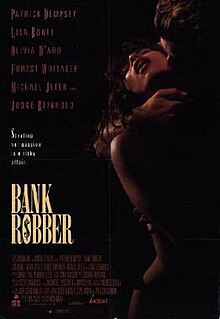Bank Robber (film)
| Bank Robber | |
|---|---|
 Movie Poster | |
| Directed by | Nick Mead |
| Written by | Nick Mead |
| Produced by | Lila Cazès |
| Starring | |
| Cinematography | Andrzej Sekuła |
| Edited by | Maysie Hoy Richard E. Westover |
| Music by | Stewart Copeland |
| Distributed by | I.R.S. Releasing Corporation |
Release date |
|
Running time | 91 minutes |
| Country | United States |
| Language | English |
| Budget | $2 million[1] |
| Box office | $115,842 (USA) |
Bank Robber is a 1993 American crime film written and directed by Nick Mead in his directorial debut.
Plot
[edit]This article needs an improved plot summary. (April 2020) |
Billy is a well-dressed bank robber who decides to do one last heist so he can sail off to a tropical island with his girlfriend, Selina. On his last robbery, he forgets to destroy a surveillance camera. He then must hide out in the Heartbreak Hotel until he can get out of trouble. On the way everyone he knows wants a cut of his money, including hotel clerks and pizza delivery boys, who all recognize him. Back at the bank, the police chief and bank manager use the heist as a cover for them opening the vault and passing out the money, as Billy only went for the tellers' cash. The police chief himself speaks of buying an RV.
While Billy is seeing Selina, a broadcast comes through, and the police chief announces Billy wasn't the robber of the bank. When Billy starts to get paranoid in his hotel room, he gets desperate. Billy then dresses up, leaves the motel, and meets two cops in the street who shoot him, then carry him off to Pricilla, a prostitute. She pays them and drives away with a wounded Billy. Sometime later she is seen on a beach with Billy watching a sunset.
Cast
[edit]| Actor | Role |
|---|---|
| Patrick Dempsey | Billy |
| Lisa Bonet | Priscilla |
| Judge Reinhold | Officer Gross |
| Forest Whitaker | Officer Battle |
| Olivia d'Abo | Selina |
| Mariska Hargitay | Marisa Benoit |
| Michael Jeter | NC1 |
| Paula Kelly | Mother |
| Stephen McDonough | Andy |
Critical reception
[edit]Stephen Holden of The New York Times gave it a mixed to negative review:
The humor is both too oblique and too mild-mannered for the movie to cohere as a modern comic fable. It amounts to little more than a series of loosely connected tangents that come to an abrupt and unsatisfying conclusion.[2]
References
[edit]- ^ "AFI|Catalog".
- ^ Holden, Stephen (10 December 1993). "Original New York Times review". Movies.nytimes.com. Retrieved 18 October 2010.
External links
[edit]
